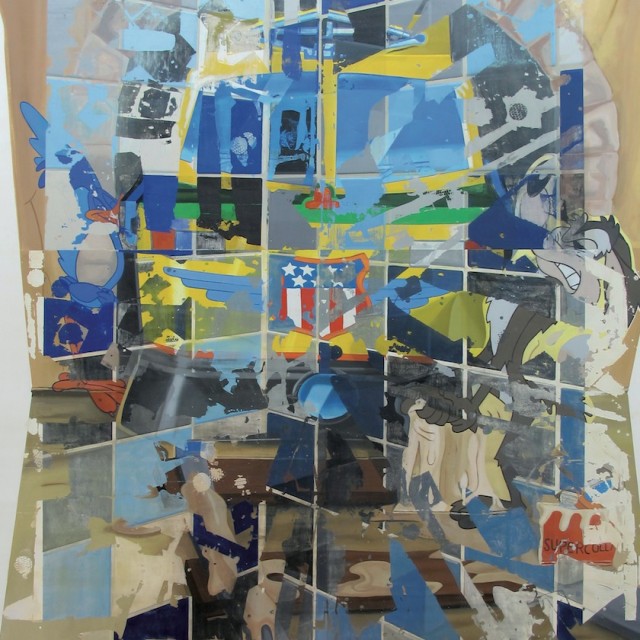Madre museum presents from February 8 to May 12, 2014, the first and most extensive exhibition ever dedicated by any public institution, not just Italian, to the work of the Irish artist Pádraig Timoney (Derry, 1968), who lives and works in New York.
This mid-career retrospective – which includes more than fifty works created over the last twenty years – also represents a symbolic return of the artist to Naples, a city that Timoney had chosen as his place of residence and production from 2004 to 2011, before moving to New York. The artist pays homage to Naples starting with the title of the show, which cites the opening words of ‘O Cunto ‘E Masaniello, a song published in 1974 by Nuova Compagnia di Canto Popolare.
Pádraig Timoney’s work is a deep and personal exploration of all the languages of painting and the nature of images, created with different means of expression: in addition to the main medium of painting, the artist makes use of photography, sculpture and installation, creating a visual universe marked by a radical eclecticism. Before a series of works by Timoney, you may have the impression of being in a group exhibition, the styles, techniques and moods that define his work are that different: abstraction coexists with the most faithful photo-realism, movement is accompanied by an almost meditative aesthetic, while a scholarly relationship with the history of art is combined with an understanding of the more contemporary, even trivial, aspects of our globalised and digital culture.
The apparent incongruity of shapes and languages that distinguishes the work of Padraig Timoney corresponds, in fact, to a rigorous and fully deliberate artistic strategy, at the heart of which we find a critique of the notion of “style” as the desire to explore art in all its aesthetic and conceptual potential. The concept of style as a unitary and identifiable factor is a pillar on which the history of art is founded, an assumption that Timoney calls into question by juxtaposing apparently opposite and irreconcilable codes and moods, thus doing justice to the multiplicity of shapes with which reality presents itself before our eyes, to the way of perceiving and understanding it and to the complexity of ways in which we relate to images, their meanings and their history.
The apparent eclecticism of Pádraig Timoney has its roots in a wide range of artistic experiences more or less recent, thus revealing a cultured practice but one in which the viewer is left free to seek his own horizon of meaning. The ambiguity that Timoney pursues among image, media and language, between visual information and its material reality, evokes the painting of surrealist tradition, from the visual and linguistic paradoxes of René Magritte to the enigmatic quality of materials and shapes of Max Ernst. Timoney blends together the illusion of Étant donnes, the last work of Marcel Duchamp – with the use of windows and doors in the work of the French artist – and the interpretation that the Renaissance gave of the painting as a window and a view of reality, as is evident from some of the works on display such as Sade’s Versus Lacoste (2007), Untitled – meepmeep popup (2011) and Untitled – Starry Mantle and the Door (2007).
The deeply photographic nature of much of the Timoney’s work and his ceaseless experimentation with materials and media also clearly show the reflections of the artist on the work of artists such as Robert Rauschenberg, Andy Warhol, Gerhard Richter and Sigmar Polke, just to name a few. The richness of this reflection is explicit not only in works that reveal an immediate photographic matrix – such as Capass (2010) and Detroit (2003) – but also and especially in the many works based on an investigation of the mechanisms of vision and transmission of images, starting from those based on the refraction device – such as Diffraction Grate – Falling Grills (2008) – and on the reflection of a silhouette, such as Stari Most (2007). The European tradition of Informal painting and that American of Minimalist painting finally found an echo in the deep meditation that Timoney reveals on processes and materials, interpreted in their organic, temporal and changeable nature. Examples are numerous works in which rabbit skin glue – a material traditionally used in the past in the preparation of the canvas – is mixed with pigments and becomes the painting itself, thus transforming a process that is part of the DNA of painting to an image.
The exhibition will be accompanied by the most extensive monograph ever produced on the artist’s work, published by Electa and edited by Alessandro Rabottini, containing over 140 colour reproductions and critical essays by Gavin Delahunty, Head of Exhibitions and Displays at Tate Liverpool, by Dominic Molon, Curator of Contemporary Art at Rhode Island School of Design Museum, Providence, and by the curator of the exhibition.
Pádraig Timoney’s work has been exhibited at prestigious international institutions such as MART – Museum of Modern and Contemporary Art of Trento and Rovereto, the Tate Gallery in Liverpool, the Henry Moore Institute in Leeds, the Frances Young Tang Teaching Museum and Art Gallery in New York City, Castel Sant’ Elmo in Naples, the Scottish National Gallery of Modern Art in Edinburgh, the Liverpool Biennial and Transmission Gallery in Glasgow.
